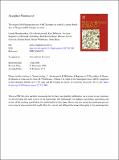The origin of the Palaeoproterozoic AMCG complexes in the Ukrainian Shield : new U-Pb ages and Hf isotopes in zircon
Abstract
The Ukrainian shield hosts two Palaeoproterozoic anorthosite-mangerite-charnockite-granite (AMCG) complexes (the Korosten and Korsun-Novomyrhorod complexes) that intruded Palaeoproterozoic continental crust in north-western and central parts of the shield, respectively. We report results of U-Pb zircon and baddeleyite dating of 16 samples from the Korosten plutonic complex (KPC), and 6 samples from the Korsun-Novomyrhorod plutonic complex (KNPC). Fifteen zircon samples from both complexes were also analysed for Hf isotopes. These new, together with previously published data indicate that the formation of the KPC started at c. 1815 Ma and continued until 1743 Ma with two main phases of magma emplacement at 1800-1780 and 1770-1758 Ma. Each of the main phases of magmatic activity included both basic and silicic members. The emplacement history of the KNPC is different from that of the KPC. The vast majority of the KNPC basic and silicic rocks were emplaced between c. 1757 and 1750 Ma; the youngest stages of the complex are represented by monzonites and syenites that were formed between 1748 and 1744 Ma. Both Ukrainian AMCG complexes are closely associated in space and time with mantle-derived mafic and ultramafic dykes. The Hf isotope ratios in the zircons indicate a predominantly crustal source for the initial melts with some input of juvenile Hf from mantle-derived tholeiite melts. The preferred model for the formation of the Ukrainian AMCG complexes involves the emplacement of large volumes of hot mantle-derived tholeiitic magma into the lower crust. This resulted in partial melting of mafic lower-crustal material, mixing of lower crustal and tholeiitic melts, and formation of ferromonzodioritic magmas. Further fractional crystallization of the ferromonzodioritic melts produced the spectrum of basic rocks in the AMCG complexes. Emplacement of the ferromonzodioritic and tholeiitic melts into the middle crust and their partial crystallization caused abundant melting of the ambient crust and formation of the large volumes of granitic rocks present in the complexes.
Citation
Shumlyanskyy , L , Hawkesworth , C , Billström , K , Bogdanova , S , Mytrokhyn , O , Romer , R , Dhuime , B , Claesson , S , Ernst , R , Whitehouse , M & Bilan , O 2017 , ' The origin of the Palaeoproterozoic AMCG complexes in the Ukrainian Shield : new U-Pb ages and Hf isotopes in zircon ' , Precambrian Research , vol. 292 , pp. 216-239 . https://doi.org/10.1016/j.precamres.2017.02.009
Publication
Precambrian Research
Status
Peer reviewed
ISSN
0301-9268Type
Journal article
Description
This research gained financial support granted by the Royal Society, UK (2006/R4 IJP), and the Swedish Institute, Sweden. This paper is NORDSIM contribution number 484, and publication no. 62 of the Large Igneous Provinces – Supercontinent Reconstruction – Resource Exploration Project (CAMIRO Project 08E03, and NSERC CRDPJ 419503-11) (www.supercontinent.org, www.camiro.org/exploration/ongoing-projects), and a contribution to IGCP 648.Collections
Items in the St Andrews Research Repository are protected by copyright, with all rights reserved, unless otherwise indicated.

